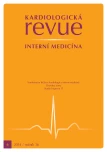Combination hypolipidemic therapy
Authors:
M. Vráblík
Authors‘ workplace:
Centrum preventivní kardiologie, 3. interní klinika 1. LF UK a VFN v Praze
Published in:
Kardiol Rev Int Med 2014, 16(6): 458-463
Category:
Cardiology Review
Overview
Co-administration of more than one drug targeting cardiovascular risk by impacting on serum lipoprotein metabolism is used much less than combinations in the treatment of arterial hypertension or type 2 diabetes. The most commonly used lipid lowering drugs are statins, which may combined with ezetimibe or bile acid sequestrants when a more significant decrease of LDL-cholesterol is required. In mixed dyslipidemia, particularly in the context of type 2 diabetes, statins may be combined with fibrates, or even with pharmacological doses of omega-3 fatty acids. On the contrary, the results of the latest clinical trials have shown that niacin has lost its position in the treatment of dyslipidemia. The results of clinical trials with brand-new molecules used in the treatment of dyslipidemia hold great promise – in particular, monoclonal antibodies against PCSK9 seem to offer unprecedented possibilities of impacting on lipid metabolism. However, they will also be present mainly within the combination lipid lowering regimens. Triple - and multiple-lipid lowering combos are not supported by clinical trial data, but they might be used in individual cases for the benefit of our patients.
Keywords:
cardiovascular risk – dyslipidemia – lipid lowering combination – statins – fibrates – ezetimibe – resins – PCSK9 inhibitors
Sources
1. Brown GB, Zhao XQ. Nicotinic acid, alone and in combinations, for reduction of cardiovascular risk. Am J Cardiol 2008; 101 : 58B – 62B. doi: 10.1016/ j.amjcard.2008.02.039.
2. Law MR, Wald NJ, Rudnicka AR. Quantifying effect of statins on low density lipoprotein cholesterol, ischaemic heart disease, and stroke: systematic review and meta‑analysis. BMJ 2003; 326 : 1423 – 1430.
3. Vrablík M, Freiberger T, Lánská V et al. Projekt Atractiv: zlepšení kardiovaskulární prevence v podmínkách primární péče v České republice. Vnitř Lék 2008; 54 : 1131 – 1139.
4. Barter P, Gotto AM, LaRosa JC et al. HDL cholesterol, very low levels of LDL cholesterol and cardiovascular events. N Engl J Med 2007; 357 : 1301 – 1310.
5. Vrablík M. Reziduální riziko kardiovaskulárních příhod. Medicína po promoci 2009; 10 : 60 – 64.
6. Chew EY, Ambrosius WT, Davis MD et al. The ACCORD Study Group and ACCORD Eye Study Group. Effects of combination lipid therapy in type 2 diabetes mellitus. N Engl J Med 2010; 363 : 233 – 244. doi: 10.1056/ NEJMoa1001288.
7. Davidson MH, Ballantyne CM, Kerzner B et al. Efficacy and safety of ezetimibe coadministered with statins: randomised, placebo ‑ controlled, blinded experience in 2382 patients with primary hypercholesterolemia. Int J Clin Pract 2004; 58 : 746 – 755.
8. Sharp Collaborative Group. Study of Heart and Renal Protection (SHARP): randomized trial to assess the effects of lowering low ‑ density lipoprotein cholesterol among 9,438 patients with chronic kidney disease. Am Heart J 2010; 160 : 785 – 794. doi: 10.1016/ j.ahj.2010.08.012.
9. Califf RM, Lokhnygina Y, Cannon CP et al. An update on the Improved Reduction of Outcomes: Vytorin Efficacy International Trial (IMPROVE ‑ IT) design. Am Heart J 2010; 159 : 705 – 709. doi: 10.1016/ j.ahj.2010.03.004.
10. Bays HE, Goldberg RB. The 'forgotten' bile acid sequestrants: is now a good time to remember? Am J Ther 2007; 14 : 567 – 580.
11. Handelsman Y. Role of bile acid sequestrants in the treatment of type 2 diabetes. Diabetes Care 2011; 34 (Suppl 2): S244 – S250. doi: 10.2337/ dc11 ‑ s237.
12. Vrablík M. Farmakoterapie dyslipidemií. Praha: Maxdorf 2012.
13. Jun M, Foote C, Lv J et al. Effects of fibrates on cardiovascular outcomes: review and meta‑analysis. Lancet 2010; 375 : 1875 – 1884. doi: 10.1016/ S0140 ‑ 6736(10)60656 ‑ 3.
14. Ginsberg HN, Elam MB, Lovato LC et al. ACCORD Study Group. Effects of combination lipid therapy in type 2 diabetes mellitus. N Engl J Med 2010; 362 : 1563 – 1574. doi: 10.1056/ NEJMoa1001282.
15. Rajamani K, Colman PG, Li LP et al. FIELD study investigators. Effect of fenofibrate on amputation events in people with type 2 diabetes mellitus (FIELD study): a prespecified analysis of a randomised controlled trial. Lancet 2009; 373 : 1780 – 1788. doi: 10.1016/ S0140 ‑ 6736(09)60698 ‑ X.
16. Farnier M, Freeman MW, Macdonell G et al. Efficacy and safety of the coadministration of ezetimibe with fenofibrate in patients with mixed hyperlipidemia. Eur Heart J 2005; 26 : 897 – 905.
17. Agouridis AP, Filippatos TD, Derdemezis CS et al. Combination of fenofibrate with non‑statin drug regimens. Curr Pharm Des 2010; 16 : 3401 – 3416.
18. Farnier M, Taggart W, Dong Q et al. Influence of simvastatin, fenofibrate and/ or ezetimibe on correlation of low ‑ density lipoprotein and nonhigh‑density lipoprotein cholesterol with apolipoprotein B in mixed dyslipidemic patients. J Clin Lipidol 2011; 5 : 179 – 187. doi: 10.1016/ j.jacl.2011.02.009.
19. Davidson MH, Stein EA, Bays HE et al. COMBination of prescription Omega ‑ 3 with Simvastatin (COMBOS) Investigators. Efficacy and tolerability of adding prescription omega ‑ 3 fatty acids 4 g/ d to simvastatin 40 mg/ d in hypertriglyceridemic patients: an 8‑week, randomized, double‑blind, placebo controlled study. Clin Ther 2007; 29 : 1354 – 1367.
20. Stein EA, Wasserman SM, Dias C et al. AMG ‑ 145. Drugs of the Future 2013; 38 : 451 – 459.
Labels
Paediatric cardiology Internal medicine Cardiac surgery CardiologyArticle was published in
Cardiology Review

2014 Issue 6
Most read in this issue
- Aortic diseases – diagnosis, classification and management principles
- Combination of anticoagulant and antiaggregant treatment in patients after myocardial infarction with an indication for anticoagulant treatment – so‑ called triple therapy
- Triple-combination in the treatment of hypertension
- When to recommend a combination of ACE-inhibitors and angiotensin receptor blockers
